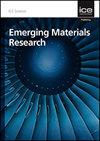The influence mechanism of lignite thermal upgrading on moisture re-adsorption
IF 1.2
4区 材料科学
Q4 MATERIALS SCIENCE, MULTIDISCIPLINARY
引用次数: 0
Abstract
The influence mechanism of lignite thermal upgrading on moisture re-adsorption was investigated using analytical instruments as DTA-TG, FTIR, SEM. The results showed that the moisture content of lignite decreased from 44.78% to 25.07% through the drying process. After the moisture in the lignite and the air reached a dynamic equilibrium, the moisture content of the lignite was 25.75 wt.%. The characteristic functional groups of lignite include hydroxyl, methylene, methyl, carbonyl, carboxyl and ether oxygen. The adsorption distances of the five adsorption sites of carboxyl, phenolic hydroxyl, alcoholic hydroxyl, carbonyl and ether bond to water molecules were 2.081 Å, 2.933 Å, 1.905 Å, 1.860 Å and 1.881 Å, respectively. The order of the adsorption strength of water molecules on the characteristic functional groups was: Carbonyl>Phenolic hydroxyl>Ether oxygen >Alcoholic hydroxyl>Carboxyl. During the upgrading by drying process, the characteristic functional groups that were prone to hydrogen bonds of water molecules partially decomposed. The reduction of pores and the partial decomposition of hydrophilic functional groups after upgrading in the lignite structure made the adsorption capacity of lignite to water molecules weakened. Therefore, the re-absorption of water molecules by lignite was reduced.褐煤热改性对水分再吸附的影响机理
利用DTA-TG、FTIR、SEM等分析仪器研究了褐煤热改性对水分再吸附的影响机理。结果表明,经过干燥过程,褐煤的水分含量从44.78%下降到25.07%。褐煤和空气中的水分达到动态平衡后,褐煤的水分含量为25.75 褐煤的特征官能团包括羟基、亚甲基、甲基、羰基、羧基和醚氧。羧基、酚羟基、醇羟基、羰基和醚键五个吸附位点对水分子的吸附距离为2.081 Å,2.933 Å,1.905 Å,1.860 Å和1.881 Å。水分子对特征官能团的吸附强度顺序为:羰基>酚羟基>醚氧>醇羟基>羧基。在干燥过程中,水分子中易于形成氢键的特征官能团部分分解。褐煤结构升级后孔隙的减少和亲水官能团的部分分解使褐煤对水分子的吸附能力减弱。因此,褐煤对水分子的再吸收减少了。
本文章由计算机程序翻译,如有差异,请以英文原文为准。
求助全文
约1分钟内获得全文
求助全文
来源期刊

Emerging Materials Research
MATERIALS SCIENCE, MULTIDISCIPLINARY-
CiteScore
4.50
自引率
9.10%
发文量
62
期刊介绍:
Materials Research is constantly evolving and correlations between process, structure, properties and performance which are application specific require expert understanding at the macro-, micro- and nano-scale. The ability to intelligently manipulate material properties and tailor them for desired applications is of constant interest and challenge within universities, national labs and industry.
 求助内容:
求助内容: 应助结果提醒方式:
应助结果提醒方式:


